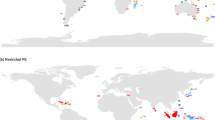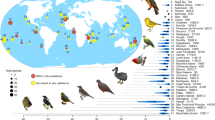Abstract
A fundamental question in evolutionary ecology and conservation biology is: why do some areas contain greater species diversity than others? Island biogeographic theory has identified the roles of immigration and extinction in relation to area size and proximity to source areas1,2, and the role of speciation is also recognized as an important factor3,4,5,6. However, one as yet unexplored possibility is that species diversity itself might help to promote speciation, and indeed the central tenets of island biogeographic theory support such a prediction. Here we use data for plants and arthropods of the volcanic archipelagos of the Canary and Hawaiian Islands to address whether there is a positive relationship between species diversity and rate of diversification. Our index of diversification for each island is the proportion of species that are endemic, and we test our prediction that this increases with increasing species number. We show that even after controlling for several important physical features of islands, diversification is strongly related to species number.
This is a preview of subscription content, access via your institution
Access options
Subscribe to this journal
Receive 51 print issues and online access
$199.00 per year
only $3.90 per issue
Buy this article
- Purchase on Springer Link
- Instant access to full article PDF
Prices may be subject to local taxes which are calculated during checkout



Similar content being viewed by others
References
MacArthur, R. H. & Wilson, E. O. An equilibrium theory of insular zoogeography. Evolution 17, 373–387 (1963)
MacArthur, R. H. & Wilson, E. O. The Theory of Island Biogeography (Princeton Univ. Press, Princeton, 1967)
Gillespie, R. Community assembly through adaptive radiation in Hawaiian spiders. Science 303, 356–359 (2004)
Hubbell, S. P. The Unified Neutral Theory of Biodiversity and Biogeography (Princeton Univ. Press, Princeton, 2001)
Losos, J. B. & Schluter, D. Analysis of an evolutionary species–area relationship. Nature 408, 847–850 (2000)
Heaney, L. R. Dynamic disequilibrium: a long-term, large-scale perspective on the equilibrium model of island biogeography. Global Ecol. Biogeogr. 9, 59–74 (2000)
Rosenzweig, M. L. Species Diversity in Time and Space (Cambridge Univ. Press, Cambridge, 1995)
Tokeshi, M. Species Coexistence: Ecological and Evolutionary Perspectives (Blackwell, Oxford, 1999)
Carson, H. L. & Clague, D. A. in Hawaiian Biogeography: Evolution on a Hotspot Archipelago (eds Wagner, W. L. & Funk, V. A.) 14–29 (Smithsonian Institution Press, Washington DC, 1995)
Price, J. P. & Elliott-Fisk, D. L. Topographic history of the Maui Nui complex, Hawai'i, and its implications for biogeography. Pacif. Sci. 58, 27–45 (2004)
Price, J. P. Floristic biogeography of the Hawaiian Islands: influences of area, environment and paleogeography. J. Biogeogr. 31, 487–500 (2004)
Acebes Ginovés, J. R., et al. in Lista de Especies Silvestres de Canarias (Hongos, Plantas y Animales Terrestres) (eds Izquierdo, I., Martín, J. L., Zurita, N. & Arechavaleta, M.), 2nd edn (Consejería de Política Territorial y Medio Ambiente Gobierno de Canarias, La Laguna, Tenerife, in the press)
Oromí, P. & Báez, M. in Lista de Especies Silvestres de Canarias (Hongos, Plantas y Animales Terrestres) (eds Izquierdo, I., Martín, J. L., Zurita, N. & Arechavaleta, M.), 2nd edn (Consejería de Política Territorial y Medio Ambiente Gobierno de Canarias, La Laguna, Tenerife, in the press)
Nishida, G. M. Bishop Museum—Hawaiian arthropod checklist. 〈http://www2.bishopmuseum.org/HBS/checklist/query.asp?grp=Arthropod〉 (2002).
Roos, M. C., Kessler, P. J. A., Gradstein, S. R. & Baas, R. Species diversity and endemism of five major Malesian Islands: diversity–area relationships. J. Biogeogr. 31, 1893–1908 (2004)
Hobohm, C. Plant species diversity and endemism on islands and archipelagos, with special reference to the Macaronesian Islands. Flora 195, 9–24 (2000)
Buckling, A., Kassen, R., Bell, G. & Rainey, P. B. Disturbance and diversity in experimental microcosms. Nature 408, 961–964 (2000)
Kassen, R., Buckling, A., Bell, G. & Rainey, P. B. Diversity peaks at intermediate productivity in a laboratory microcosm. Nature 406, 508–512 (2000)
Rainey, P. B. & Travisano, M. Adaptive radiation in a heterogeneous environment. Nature 394, 69–72 (1998)
Quinn, G. P. & Keough, M. J. Experimental Design and Data Analysis for Biologists (Cambridge Univ. Press, Cambridge, 2002)
Draper, N. R., Guttman, I. & Lapczak, L. Actual rejection levels in a certain stepwise test. Commun. Statist. A 8, 99–105 (1979)
Acknowledgements
We thank W. Sutherland, G. Hewitt, M. Taylor and T. Givnish for constructive comments.
Author information
Authors and Affiliations
Corresponding author
Ethics declarations
Competing interests
The authors declare that they have no competing financial interests.
Supplementary information
Supplementary Data
This file contains additional analyses to ensure results were not simply a statistical artefact from non-independence between measures of diversification and species richness. This file also contains Supplementary Table S1. (DOC 58 kb)
Rights and permissions
About this article
Cite this article
Emerson, B., Kolm, N. Species diversity can drive speciation. Nature 434, 1015–1017 (2005). https://doi.org/10.1038/nature03450
Received:
Accepted:
Issue Date:
DOI: https://doi.org/10.1038/nature03450
This article is cited by
-
Intrahost evolution of the gut microbiota
Nature Reviews Microbiology (2023)
-
Accelerated body size evolution in upland environments is correlated with recent speciation in South American freshwater fishes
Nature Communications (2023)
-
Machine learning approaches identify male body size as the most accurate predictor of species richness
BMC Biology (2020)
-
Bacterial adaptation is constrained in complex communities
Nature Communications (2020)
-
Leaf area and pubescence drive sedimentation on leaf surfaces during flooding
Oecologia (2020)
Comments
By submitting a comment you agree to abide by our Terms and Community Guidelines. If you find something abusive or that does not comply with our terms or guidelines please flag it as inappropriate.



